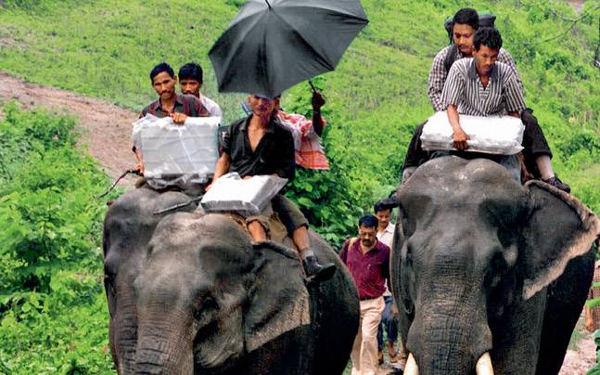The first thing former chief election commissioner SY Quraishi’s astute eye catches is the Prime Minister’s portrait on the wall of a government office in the Capital. It violates election rules, he notes, and officials scamper to have it removed. A strict enforcement of the Model Code of Conduct (MCC) — a set of regulations in place during the election season — is among the Election Commission of India’s (ECI) main roles as it helms the largest democratic event on earth — the Indian elections.
The Lok Sabha polls throw up multiple challenges for the ECI — from enforcing the MCC to tackling muscle and money power. But foremost among them is the logistics of the election.
“What makes the Indian elections a spectacle is the size and the complexity of the process. It is not only the biggest election in the world, it is the biggest management event of any kind,” Quraishi says.
In May 2019, at the end of a winding process stretching over 43 days and across seven phases, 900 million eligible voters — the combined population of Europe and Central America — will choose the next government.
The election to the 17th Lok Sabha will be executed by a task force of nearly 11 million civilian and security personnel, many of whom will trek across inhospitable terrain to get to the last voter. Polling stations — 10,35,927 in all — are spread across 29 states and seven Union territories.
The elections are a logistical nightmare, but all eyes — national and international — are on the polls. It is not without reason that former governor Gopalkrishna Gandhi, in his preface to Quraishi’s book An Undocumented Wonder: The Making of the Great Indian Elections, calls the electoral democracy India’s third best-known export to the world, after the Taj Mahal and Mahatma Gandhi.
Surprisingly, the ECI, the institution that steers this exercise, is a rather small body of 450 officers and staff. It raises its massive army by dipping into the reservoir of government officials.
“During the election period a vast number of additional officers and staff are temporarily drafted who all work subject to supervision, direction, control and discipline of the Commission. They function mainly as polling and counting officials,” says the Commission on its website.
In his book, Quraishi “unravels the myths and mystery behind the great election machine”. He walks the reader through its various aspects — from reaching the last voter in a remote area to reining in local satraps and handling fraught situations. Quraishi recalls former CEC TN Seshan’s quip to him as the junior colleague monitored the Bihar election in 1996. “Don’t worry, nothing will happen — except a bomb on your face and a bullet through your stomach!” Quraishi was grateful to return home with his stomach intact, but not before witnessing two crude bomb explosions 20 feet from him.
The ECI takes pains to track down and reach every last voter. In fact, ‘No voter to be left behind’ is the guiding principle for the ongoing election. It is little surprise then that the last-mile connectivity to a few polling stations is exercised on mules, camels, bullock carts, and even elephants.
“Sometimes we’ve a polling station for a single voter, like the one in Gujarat and another in Arunachal Pradesh,” says Quraishi. The book refers to a booth in Charangattu estate in Kerala’s Vadakara seat. It was set up in 2004 after attempts to move its only voter, Charangattu Dasan, to a nearby centre failed. A party of six officials, including polling officers and policemen, waited till noon for the first — and last — vote to be cast there.
Likewise, in Gujarat’s Gir forests, a polling booth has been set up for the last 30 years for a single voter — the priest of the Banej temple. Elections are the only time the priest has human company at night, as polling officials reach the spot a day in advance to enable him to vote.
For all its functions though, the one that is most prized by the ECI is its independence, the power to act impartially. “Neutrality is totally non-negotiable,” asserts Quraishi. The bureaucracy, the crucial players in executing elections, is chosen carefully. “If there is ever a perception that someone is partisan, we remove him. We cannot take chances; we have to deliver a good election every time,” he tells BLink.
However, the ECI has come under attack recently, for its meek response to widespread violations of the MCC and misinformation campaigns of enemy states. In an unprecedented move, 66 former bureaucrats wrote to the President earlier this week, complaining about a “crisis of credibility” in the current ECI that is “endangering the integrity of the electoral process”. As a former head of the institution, Quraishi agrees the biggest challenge now for the ECI is its image. “It has never been under attack as it is now. When an institution loses credibility, every decision made by it will be under scrutiny. There should not be a perception among the public that it is, or is perceived to be, under pressure,” he asserts.
Quick takes
• The first Indian general election in 1951-52 was conducted over 68 days
• The only photographs allowed in a polling station are those of MK Gandhi and the President.
• Hikkim, at 15,000 feet in Himachal Pradesh’s Spiti district, hosts the highest polling station in India.
Source: THB
Image Courtesy:IT
You may also like
-
India Can’t Afford to Remain Stagnant at this Juncture, Says PM Modi; Asks People to Buy Locally-Made Goods
-
Stolen Artefacts to be Returned to India from Scotland Museums
-
Netaji’s Hologram Statue at India Gate
-
10th Century Stone Idol of Goat Head Yogini IllegallyRemoved from A Temple in Lokhari, Banda, UP Being Returned to India
-
UNESCO Inscribes ‘Durga Puja in Kolkata’ on the Representative List of Intangible Cultural Heritage of Humanity
